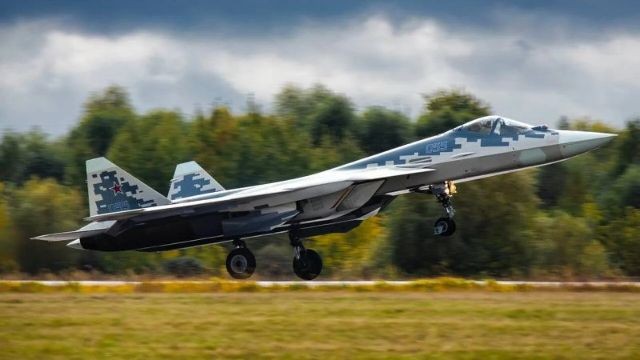A Rostec representative explained: “ The Su-57 can engage enemy fighters and destroy ground and water targets. It is being mass produced and deployed in war zones.”
“In addition, the Su-57 is also conducting tests with the second stage engine. We plan to soon deliver aircraft with this new ‘heart’.”
When discussing the uniqueness of the Su-57, Rostec emphasized the stealth characteristics that set it apart from other Russian fighters such as the Su-30, Su-35 or MiG-35. However, the stealth aspect of the Su-57 has not been widely publicized, or even fully realized.
Radar reflectivity area (RCS) measures the detectability of an object by radar, which is essential in assessing the stealth capabilities of military aircraft.
The Russian-designed Su-57 is often compared to other fifth-generation fighters, such as China’s J-20 and America’s F-35 and F-22, in terms of RCS.
The Su-57 is estimated to have an RCS of about 0.1 – 1 m 2 . This shows that although Felon possesses stealth features, it cannot reach the level of similar American aircraft.
Russia’s fifth-generation fighter incorporates radar-absorbing materials and a special design to minimize the RCS index.
Despite efforts, many experts believe that Russian aircraft are completely unable to match the level of stealth that the F-22 and F-35 possess.
 |
| The Su-57 Felon is not called a stealth fighter by many military experts. |
J-20 – China’s advanced fifth generation fighter, is said to have an RCS index between 0.01 and 0.1 m2.
The J-20 design prioritizes stealth with a multi-angled body frame, internal weapons compartments and radar-absorbing coating. However, some experts believe that equipping canards will greatly affect its stealth feature.
On the other hand, the US-developed F-35 has an estimated RCS of about 0.005 m2. Outstanding stealth is achieved through advanced technologies including radar absorbing materials.
Optimized airframe design with internal weapons bay offers many advantages. The F-35’s stealth capabilities bring high efficiency in modern combat situations.
The F-22 Raptor – another American fifth generation fighter, takes stealth to a new level with an estimated RCS of 0.0001 to 0.0005 m2.
Considered by many to be the best stealth fighter available today, the F-22’s design incorporates radar absorbing materials and meticulous attention to detail to minimize RCS. low, making it difficult for enemy radar systems to detect and track.
F-16 Fighting Falcon – famous American fighter aircraft with an RCS of about 1.2 m2. This number may vary depending on the specific version and any modifications made to reduce visibility on radar screens.
Eurofighter Typhoon is the result of cooperation between several European countries, its RCS is estimated at 0.5 m2. Like the F-16, the Typhoon’s RCS can vary depending on the specific configuration and additional measures taken to enhance its stealth capabilities.
Dassault Rafale – French multi-role fighter, although not a fifth-generation fighter, has impressive stealth capabilities. Rafale’s RCS estimates range from 0.1 – 1 m2.
The stealth characteristics of the Rafale and the Su-57 are practically the same. The question is whether Russia’s fifth generation fighter is capable of defeating Rafale in a collision situation, this cannot be clarified in the near future.





